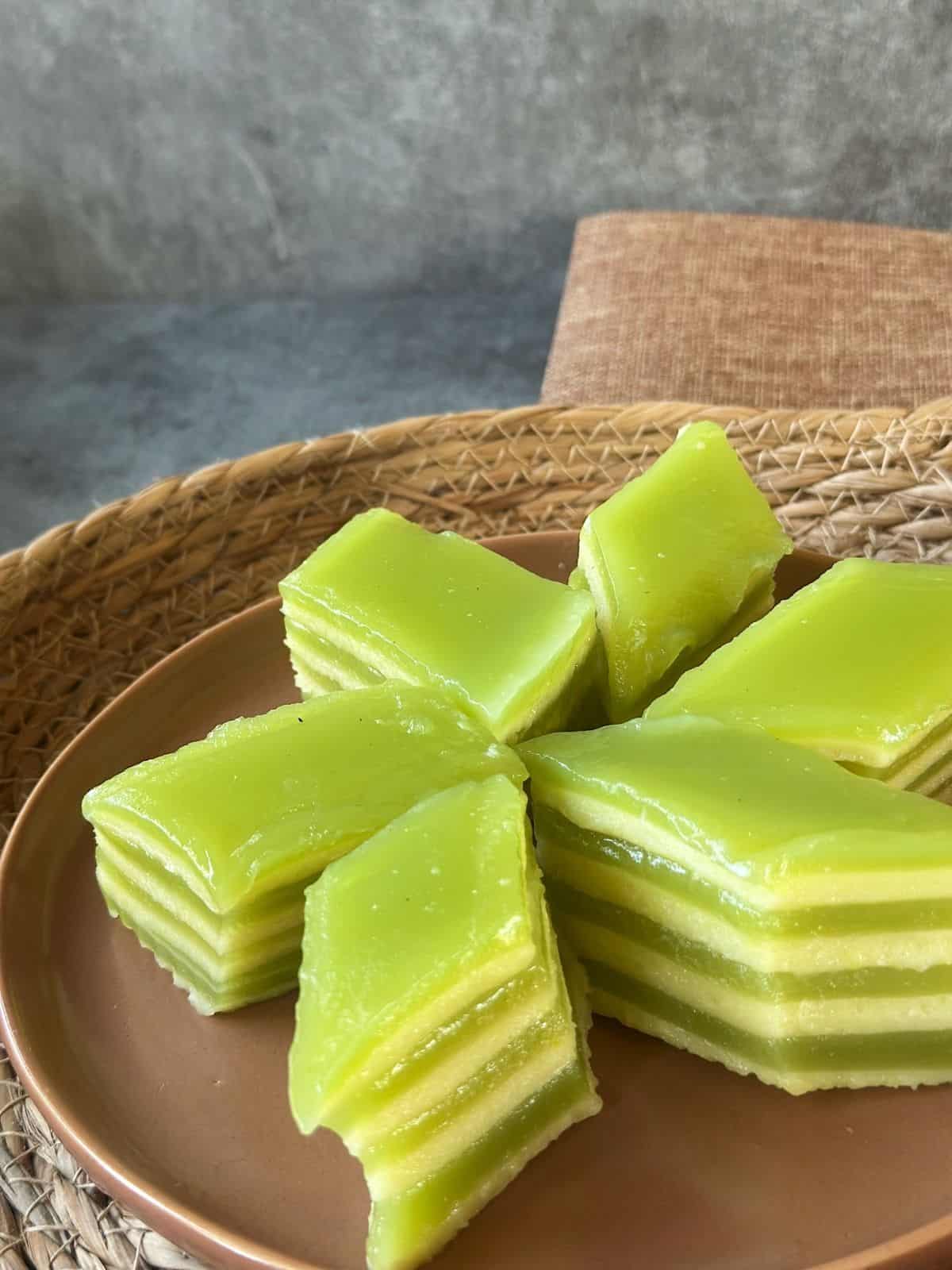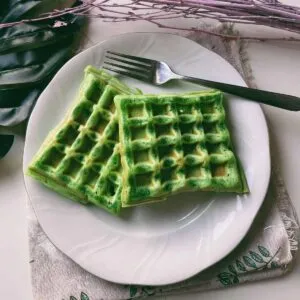Bánh Da Lợn is a soft, chewy Vietnamese layer cake with a fragrant pandan aroma and golden mung beans. Naturally gluten-free, it’s a nostalgic treat that’s far easier to make than it looks.

Bánh Da Lợn – A Southern Vietnamese Classic with Layers of Love
If you’ve ever spent time in the Mekong Delta (Miền Tây), you’ll know why people call it Vietnam’s southern treasure. The land is so fertile that fruit trees, rice, and herbs seem to grow almost effortlessly.
No wonder the food there bursts with freshness—crispy Bánh Xèo, smoky Bún Thịt Nướng, and plenty of dishes loaded with vibrant herbs and vegetables.

Then there’s Bánh Da Lợn—the colorful steamed layer cake that’s just as fun to look at as it is to eat. Its name literally means “pig skin cake,” but there’s no pork involved! The name comes from its glossy, bouncy texture that kind of reminds you of pig skin.

Each bite is soft, chewy, and lightly sweet, with layers of creamy mung bean, fragrant pandan, and rich coconut milk.
I first discovered this cake thanks to a friend’s mom in Bến Tre, who sold traditional bánh at the market. She taught me a simple trick to keep it soft and chewy for days—I’ll let you in on it in the recipe.
Like so many Vietnamese favorites, Bánh Da Lợn has cousins across Southeast Asia—Thailand’s Khanom Chan, Indonesia’s Kue Lapis… same layered charm, same addictive chew, just with a local twist.
Ingredients
Green Layer
Tapioca starch – The real MVP! This is what gives Bánh Da Lợn its iconic chewy, bouncy texture.
All-purpose flour (or rice flour for gluten-free) – I usually add a bit of wheat flour for a softer bite, but rice flour works perfectly if you want it completely gluten-free.
Coconut milk: Go for full-fat—at least 15%—so you get that rich, creamy flavor.
Granulated sugar: Just the right amount of sweetness to balance the coconut and pandan.
Pandan leaves & pandan extract: Pandan is like the vanilla of Southeast Asia. I can’t get enough of it—whether it’s in pandan bread, pandan cakes, or even a cup of pandan coffee.
Salt: Just a pinch to round everything out.
Yellow Layer
Mung beans (peeled and split) – A classic in Vietnamese desserts. Once cooked and mashed, they turn creamy with a subtle nuttiness.
Tapioca starch: Keeps the texture consistent with the green layers—still chewy, but with a smooth mung bean base.
Granulated sugar: To sweeten the mung bean layer just enough.
Coconut milk: Adds that extra depth and richness to the filling.
Turmeric powder: Just a tiny bit for a natural yellow hue—or feel free to use food coloring.
Salt: Again, just a pinch to balance the flavors.
Instructions
Green Layer
Step 1:
- Blend pandan leaves with water, then strain to extract the pandan juice. In a bowl, mix the juice with sugar, salt, tapioca starch, and all-purpose flour.
Step 2:
- Take 1 tbsp the batter and mix it with coconut milk, then cook over medium-low heat until it thickens. Once done, stir it back into the main batter along with the pandan extract and strain again for a silky-smooth texture.
- This little trick is what keeps the cake soft for days. The cooked starch traps the water inside—kind of like how Yudane or Tangzhong works when you make Asian milk bread.


Yellow Layer
Step 3:
- Combine mung beans with water and salt, then cook over medium heat. Skim off any foam and let it simmer until the water evaporates (about 20 minutes). Turn off the heat, cover with a lid, and let it rest for 15 minutes.
Step 4:
- Blend the cooked mung beans with coconut milk, sugar tapioca starch, and all-purpose flour until smooth.
- Strain the mixture, then add a small amount of turmeric powder for color (1/8-1/4 tsp)—be careful not to overdo it, as turmeric has a strong aroma.


Steam & Serve
Step 5:
- Grease the mold generously with cooking oil, covering both the bottom and sides. A silicone mold works best for easy removal.
Step 6:
- Use a kitchen scale to ensure even layers. For example, if making 3 mung bean layers and 4 pandan layers, divide the mung bean mixture into 3 equal parts and the pandan mixture into 4.
- Precise measurements help create uniform layers. In this recipe, I made 4 mung bean layers (155–158g each) and 4 pandan layers (145–148g each).
Step 7:
- Start by steaming the first mung bean layer for 3 minutes. Then, pour a pandan layer and steam for 3 minutes + 15 seconds.
- Increase the steaming time by 15 seconds for each subsequent layer. For the final layer (usually pandan), steam for 12 minutes to fully set the cake.

Step 8:
- Once done, let the cake cool completely before unmolding. Slice Bánh Da Lợn into pieces and enjoy! In Vietnam, we often serve it with Nước Cốt Dừa—a sweetened coconut sauce for extra richness.

Expert Tips
Use good pandan – Fresh pandan leaves are best, but pandan extract works too. A little goes a long way, so don’t overdo it.
Measure each layer carefully – Use a scale or the same cup for consistency, so your layers stay even.
Layering patience – Steam each layer just until it’s set but still slightly soft. Too long and it loses that signature chewy bounce.
Cut clean slices – Let the cake cool completely, then cut into squares or diamonds with a sharp knife dipped in hot water or lightly oiled for neat layers.
Enjoy it fresh – Tapioca starch firms up over time. Leftovers? A quick steam brings back that soft, chewy texture.
Optional trick – Cooking part of the batter before layering can give an even softer cake that lasts longer.
Pair it right – Bánh Da Lợn goes beautifully with Vietnamese drinks like Cà Phê Sữa Đá (iced coffee) or Sữa Bắp (sweet corn milk).
More Sweet Vietnamese Treats to Try 🍬

(Steamed Spongy Rice Cake)

(Pandan Honey Rice Cake)

(Palm Sugar Honeycomb Cake)

(Pandan Waffle)

Bánh Da Lợn: Vietnamese Steamed Pandan Cake (Soft for Days)
Equipment
- 1 Steamer
- 1 kitchen scale
Ingredients
Yellow Layer
- 70 g mung beans (peeled, split) ¼ cup
- 280 g water 1 ⅙ cups
- 280 g full-fat coconut milk 1 ⅙ cups
- 70 g granulated sugar ⅓ cup
- 85 g tapioca starch ½ cup + 1 tbsp
- 15 g all-purpose flour (or rice flour for a gluten-free option) 2 tbsp
- 1 pinch salt
- 1 pinch turmeric powder
Green Layer
- 180 g pandan juice ¾ cup (Blend 10–12 pandan leaves with 250g (1 cup) water, strain, and extract the required amount of juice.)
- ¼ tsp pandan extract
- 125 g water ½ cup
- 70 g full-fat coconut milk ¼ cup
- 70 g granulated sugar ⅓ cup
- 160 g tapioca starch ⅔ cup
- 15 g all-purpose flour (or rice flour for a gluten-free option) 2 tbsp
Instructions
- Yellow Layer:– Combine mung beans, water, and salt in a pot, then cook over medium heat. Skim off any foam and let it simmer until the water evaporates (about 20 minutes). Turn off the heat, cover, and let it rest for 15 minutes.– Blend the cooked mung beans with coconut milk, sugar, tapioca starch, and all-purpose flour until smooth. Strain the mixture, then add ⅛ to ¼ teaspoon turmeric powder for color—use sparingly, as turmeric has a strong aroma.
- Green Layer:– In a bowl, combine pandan juice, sugar, salt, tapioca starch, and all-purpose flour. Mix well.– Take 1 tbsp of the batter and mix it with coconut milk. Cook over medium-low heat until thickened.– Remove from heat, stir it back into the main batter, and strain for a smooth consistency.
- Steam & Serve:– Generously grease the mold with cooking oil, ensuring both the bottom and sides are well-coated. A silicone mold is ideal for easy release.– Use a kitchen scale for precise layering. Eg: If making 3 mung bean layers and 4 pandan layers, divide the mung bean mixture into 3 equal portions and the pandan mixture into 4. Accurate measurements ensure even layers. In this recipe, I used 4 mung bean layers (155–158g each) and 4 pandan layers (145–148g each).– Begin by steaming the first mung bean layer for 3 minutes. Next, pour a pandan layer and steam for 3 minutes + 15 seconds. Increase the steaming time by 15 seconds for each additional layer. The final layer (typically pandan) should be steamed for 12 minutes to fully set the cake.– Allow the cake to cool completely before removing it from the mold. Slice Bánh Da Lợn into pieces and enjoy! In Vietnam, it’s often paired with Nước Cốt Dừa—a sweet coconut sauce that adds extra richness.
